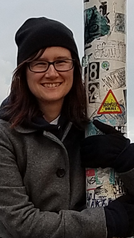 This summer I’ll spend close to three weeks on NOAA Ship Reuben Lasker in the Pacific Ocean. The NOAA Teacher at Sea program - best kept secret - is a professional development adventure open to all teachers, professors, and community educators. Each week I’ll review a book that I’ve enjoyed reading and invite you to follow my NOAA Teacher at Sea Blog. Part of the program requirements include posting a blog entry a few times each week on the NOAA website to share educational connections to the trip. Hope you enjoy! I’m presenting more about NOAA Teacher at Sea during our PCTELA Conference this October in Penn State. If anyone wants to apply, let me know and I’ll help you through the process! Educational Focus: Marine Debris
 Gone Tomorrow: The Hidden Life of Garbage Book Review 1 of 4 Reviewed by Allison Irwin PCTELA Director of Special Activities While holding this book in my hands, I feel crinkled edges and a soft, worn cover. I see smudges on the pages and a sticker on the binding that reads “USED SAVES: Textbooks from YOUR BOOKSTORE.” The sticker is ironic given the content of this text. While I can’t remember which thrift store I was at when I purchased the book, I do know that it travelled on my shelves from at least one home to another. It’s been with me, untouched, for a long time. I read this book for the first time last summer. At that point I had just barely grazed the surface of my deep water plunge into earth science. Reading Specialists don’t often have to understand science to do their job well, but throughout the last year I dove deep into the murky waters of sustainability, earth’s atmosphere and oceans, and environment. And you know what? My students seemed to enjoy the science connections we made to our lessons last year. It is clear that Heather Rogers’ purpose in writing was both efferent and aesthetic. Louise Rosenblatt (Literature - S.O.S.!, Voices from the Middle vol12 n3) wrote that the Latin for efferent is to “carry away,” and I’ve certainly carried away knowledge after reading this book. But she doesn’t seem to just want people to understand the problem, she wants us to be angry about the problem. She wants us to do something about it. She is a skilled author. Her words both captivated me and compelled me to keep reading. It made me think about my own personal consumption practices and waste. An Aesthetic Reading Rogers’ word choice is almost poetic. She includes phrases like “...famous for gallivanting on his well-groomed steed…” (p. 52). She writes of clandestine operations of a garbage barge in the 1980s that illegally dumped “a third of its cargo of toxic incinerator ash on Haiti’s beaches before slipping away under cover of night” (p. 200). Her stylistic rhythm and cadence lulled me into a woozy reader’s haze. It felt good to read this book. But no matter how much I enjoyed the reading of it, I couldn’t help but get carried away by the events and research she included to sound the alarm of impending environmental doom. An Efferent Reading She wants us to stop letting companies dictate our consumption of products. Rogers seems to be asking: Shouldn’t we be telling the manufacturers what we want and not the other way around? She makes a compelling argument midway through the book that shows how production of consumables skyrocketed in the 1950s and has been damaging our planet ever since. She writes on page 103 that “It was the age of the paper plate, polyester, fast food, disposable diapers, TV dinners, new refrigerators, washing machines and rapidly changing automobile styles. Most of all it was the epoch of packaging - lots of bright, clean, sterile packaging in the form of boxes, bags, cellophane wrappers and throwaway beer cans. The golden era of consumption had arrived, bringing the full materialization of modern garbage as we know it: soft, toxic, ubiquitous.” This chapter sits with me still. She describes how we went from a society hell bent on reusing, repairing, and restoring to one that “began making commodities that intentionally wore out faster than was technologically necessary. And because of unprecedented production efficiencies, these commodities were becoming cheaper to replace than they were to repair.” (p. 104). We’ve somehow managed to root ourselves securely into an era that does not consider the long-term consequences of our actions. Instead of buying a glass container that we could reuse for years, we insist on buying individual use soda cans, plastic bottles of water, and brightly colored, individually wrapped candies. But where does all that leftover trash go? Rogers will tell you. I found myself switching back and forth between the aesthetic and efferent with each turn of the page, each new detail, and sometimes with each new word. But it never felt abrupt or disjointed. The text flows. One word of caution, though, is that her very passionate, almost extreme perspective on saving the planet did not creep up on me until the very last chapter. Because it was such an enjoyable read, it took me a while to notice the bias. Looking back through the text now, though, I can see layers of sarcasm and opinion blended with the historical facts and research. As long as you read it with that in mind, it’s an absolutely enlightening and enjoyable read that I would recommend to anyone. Comments are closed.
|
AuthorThe PCTELA Community Archives
September 2020
Categories |
- Home
- Who We Are
-
What We Do
-
The PCTELA Newsletter
>
- The PCTELA News Blog
- The PCTELA Newsletter - Summer 2017 - Best of the Blog
- The PCTELA Newsletter - Spring 2017
- The PCTELA Newsletter - Spring 2016
- The PCTELA Newsletter - Winter 2015
- The PCTELA Newsletter - Back to School 2014
- The PCTELA Newsletter - Winter 2014
- The PCTELA Newsletter - End of Year 2012-2013
- Certificate of Merit
- NCTE Teaching Awards
- NWP
-
The PCTELA Newsletter
>
- Conference Exhibitor & Vendor Information
- Resources
- Home
- Who We Are
-
What We Do
-
The PCTELA Newsletter
>
- The PCTELA News Blog
- The PCTELA Newsletter - Summer 2017 - Best of the Blog
- The PCTELA Newsletter - Spring 2017
- The PCTELA Newsletter - Spring 2016
- The PCTELA Newsletter - Winter 2015
- The PCTELA Newsletter - Back to School 2014
- The PCTELA Newsletter - Winter 2014
- The PCTELA Newsletter - End of Year 2012-2013
- Certificate of Merit
- NCTE Teaching Awards
- NWP
-
The PCTELA Newsletter
>
- Conference Exhibitor & Vendor Information
- Resources

 RSS Feed
RSS Feed